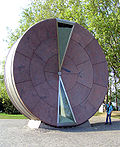Hourglass
Hourglass is a device used to measure the passage of time. It comprises two glass bulbs connected vertically by a narrow neck that allows a regulated trickle of material (historically sand) from the upper bulb to the lower one. Factors affecting the time interval measured include the amount of sand, the size of the sand particles, the size of the bulb, and the neck width.
History[edit]
The hourglass, also known as a sand clock or sandglass, dates back to the 14th century. It is one of the few reliable methods to measure time at sea. The hourglass was the ideal instrument for navigation during this period because it was not affected by the motion of the ship or changes in humidity.
Design and Function[edit]
The design of an hourglass is simple yet effective. The two bulbs of an hourglass are symmetric so that the hourglass will measure the same duration regardless of orientation. The material in the neck does not flow until the upper bulb is empty. Therefore, the hourglass continues to be accurate even if it is stopped and restarted.
Uses[edit]
Hourglasses have been used in a variety of contexts, from cooking and working to game playing and exercising. They are also used symbolically in art and culture to represent the passage of time.
See Also[edit]
References[edit]
<references />
|
|
|
Hourglass[edit]
-
Half-hour sand glass
-
E4CC appendix 2
-
Hourglass - Tokyo - 2015 11 17
-
Peleus Thetis
-
Ambrogio Lorenzetti detail Temperance
-
Clessidra 1849
-
Egg timer
-
Budapest timewheel
-
Flag of Christopher Moody
-
Cursor design hourglass
-
Hourglass cross
-
Livingstone Mausoleum detail
Ad. Transform your life with W8MD's Budget GLP-1 injections from $75


W8MD offers a medical weight loss program to lose weight in Philadelphia. Our physician-supervised medical weight loss provides:
- Weight loss injections in NYC (generic and brand names):
- Zepbound / Mounjaro, Wegovy / Ozempic, Saxenda
- Most insurances accepted or discounted self-pay rates. We will obtain insurance prior authorizations if needed.
- Generic GLP1 weight loss injections from $75 for the starting dose.
- Also offer prescription weight loss medications including Phentermine, Qsymia, Diethylpropion, Contrave etc.
NYC weight loss doctor appointmentsNYC weight loss doctor appointments
Start your NYC weight loss journey today at our NYC medical weight loss and Philadelphia medical weight loss clinics.
- Call 718-946-5500 to lose weight in NYC or for medical weight loss in Philadelphia 215-676-2334.
- Tags:NYC medical weight loss, Philadelphia lose weight Zepbound NYC, Budget GLP1 weight loss injections, Wegovy Philadelphia, Wegovy NYC, Philadelphia medical weight loss, Brookly weight loss and Wegovy NYC
|
WikiMD's Wellness Encyclopedia |
| Let Food Be Thy Medicine Medicine Thy Food - Hippocrates |
Medical Disclaimer: WikiMD is not a substitute for professional medical advice. The information on WikiMD is provided as an information resource only, may be incorrect, outdated or misleading, and is not to be used or relied on for any diagnostic or treatment purposes. Please consult your health care provider before making any healthcare decisions or for guidance about a specific medical condition. WikiMD expressly disclaims responsibility, and shall have no liability, for any damages, loss, injury, or liability whatsoever suffered as a result of your reliance on the information contained in this site. By visiting this site you agree to the foregoing terms and conditions, which may from time to time be changed or supplemented by WikiMD. If you do not agree to the foregoing terms and conditions, you should not enter or use this site. See full disclaimer.
Credits:Most images are courtesy of Wikimedia commons, and templates, categories Wikipedia, licensed under CC BY SA or similar.
Translate this page: - East Asian
中文,
日本,
한국어,
South Asian
हिन्दी,
தமிழ்,
తెలుగు,
Urdu,
ಕನ್ನಡ,
Southeast Asian
Indonesian,
Vietnamese,
Thai,
မြန်မာဘာသာ,
বাংলা
European
español,
Deutsch,
français,
Greek,
português do Brasil,
polski,
română,
русский,
Nederlands,
norsk,
svenska,
suomi,
Italian
Middle Eastern & African
عربى,
Turkish,
Persian,
Hebrew,
Afrikaans,
isiZulu,
Kiswahili,
Other
Bulgarian,
Hungarian,
Czech,
Swedish,
മലയാളം,
मराठी,
ਪੰਜਾਬੀ,
ગુજરાતી,
Portuguese,
Ukrainian













